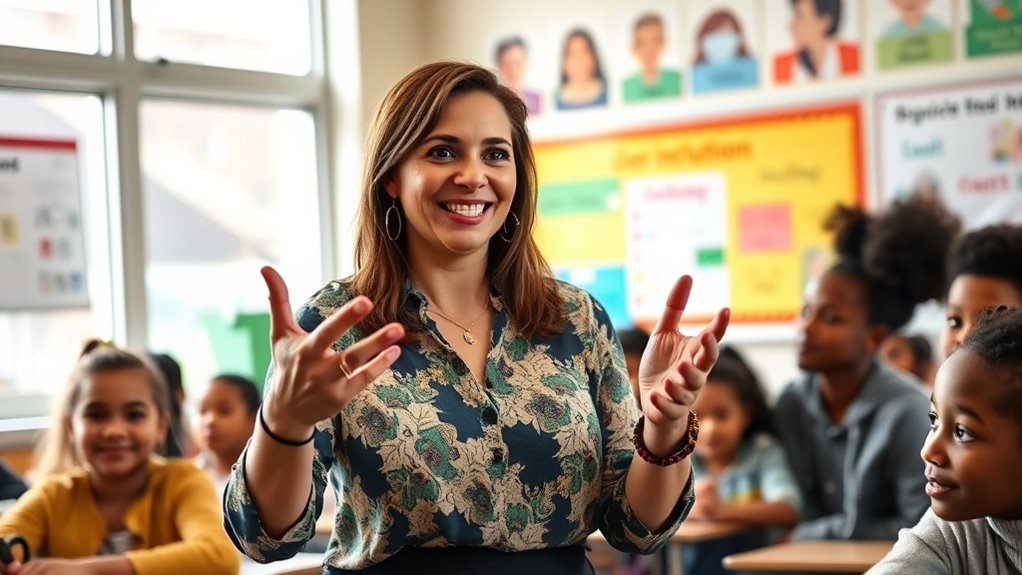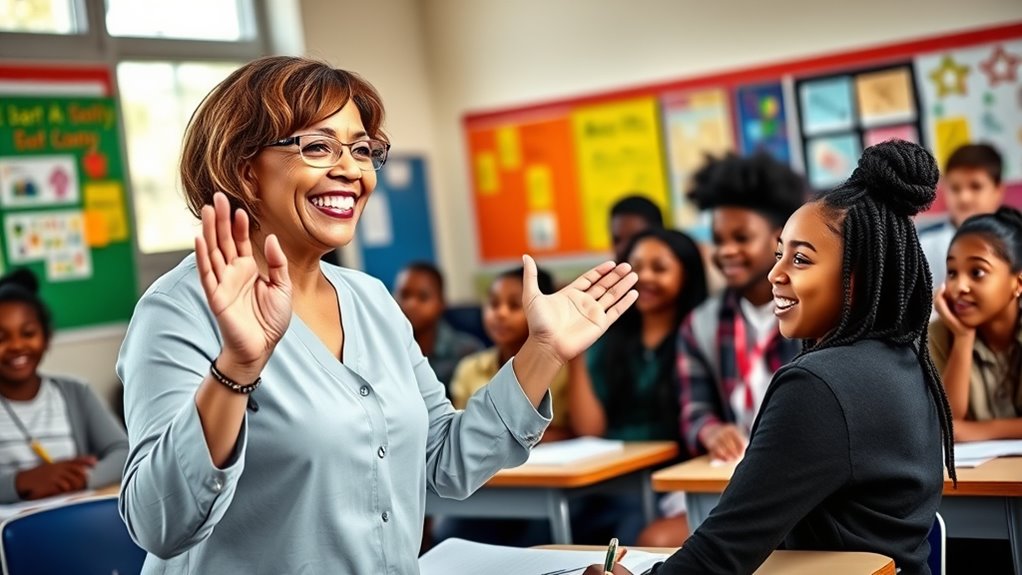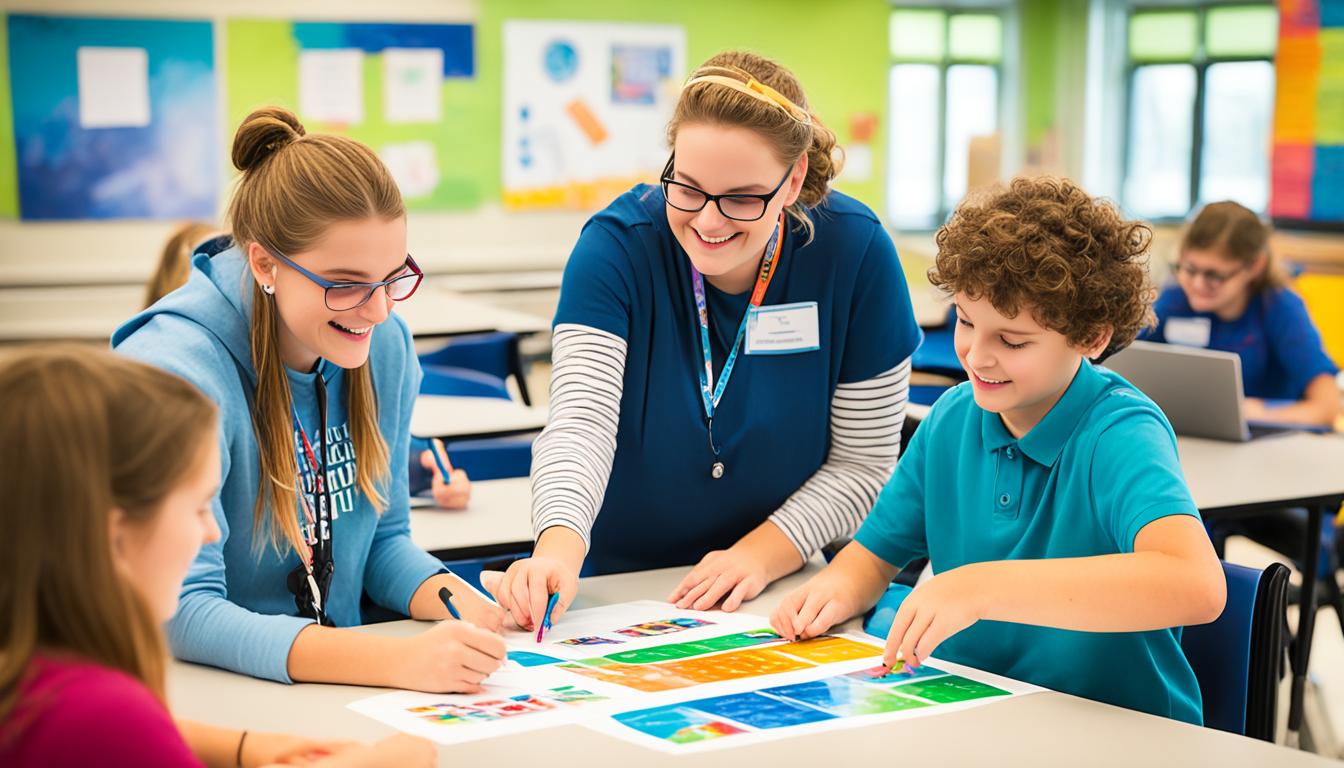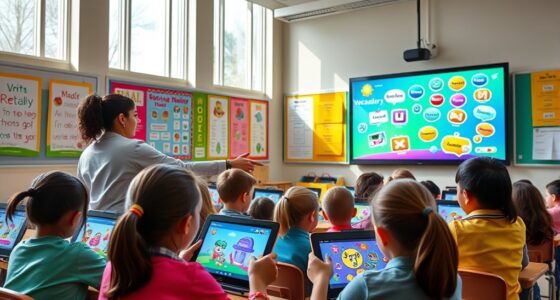Deaf teachers serve as powerful role models by showcasing the strength and richness of Deaf culture, inspiring confidence, and fostering pride in students’ identities. Their unique communication skills and cultural expertise help create inclusive, accessible classrooms where students feel valued and understood. By challenging stereotypes and breaking societal barriers, they empower learners to pursue their goals with resilience. If you keep exploring, you’ll see how their impact extends far beyond the classroom, shaping futures and communities alike.
Key Takeaways
- Deaf teachers serve as authentic role models, inspiring confidence, pride, and resilience within Deaf students and the broader community.
- Their presence promotes cultural identity, fostering a sense of belonging and preserving Deaf heritage for future generations.
- Deaf educators use unique visual communication skills to create inclusive, engaging learning environments that challenge stereotypes.
- They demonstrate that societal barriers do not limit potential, broadening perceptions of what Deaf individuals can achieve.
- The mentorship and representation by Deaf teachers empower students, encouraging personal growth and professional success.
The Power of Representation in Education

Have you ever considered how much your teachers’ backgrounds influence your learning experience? When your teacher is a Deaf individual, it brings a unique perspective through sign language and cultural competence. This representation matters because it signals that Deaf people are capable educators who understand firsthand the challenges and strengths of the Deaf community. Such teachers serve as powerful role models, breaking down stereotypes and fostering an inclusive environment. Their use of sign language not only enhances communication but also affirms Deaf culture as valuable and legitimate. This authentic representation boosts your confidence and inspires you to embrace your identity. Ultimately, having Deaf teachers enriches the educational experience, showcasing the importance of diversity and the impact of representation in shaping a more equitable learning space.
Building Cultural Identity and Pride

Celebrating Deaf heritage helps you connect with a rich history that shapes your identity. Authentic cultural representation in education shows you that your experiences and language matter. When you embrace your pride, you strengthen your sense of belonging and inspire others to do the same. Recognizing the importance of cultural identity in health can further empower you to advocate for your community’s well-being. Understanding Self Watering Plant Pots can serve as a metaphor for nurturing cultural pride and resilience within the Deaf community. Engaging in seasonal variations and natural environments enriches your understanding of your cultural roots and fosters emotional understanding and cultural expression among Deaf individuals. Appreciating cultural heritage preservation ensures that future generations continue to celebrate and uphold their identity.
Celebrating Deaf Heritage
Why is it important to honor Deaf heritage? Celebrating Deaf history helps you understand the resilience and achievements of Deaf communities. Recognizing key moments and figures in Deaf history fosters a sense of pride and belonging. Deaf art plays a crucial role in this celebration, offering a vibrant expression of culture, identity, and shared experiences. Through visual storytelling, performances, and signs, Deaf art captures the richness of Deaf culture and history. Honoring these traditions reminds you that Deaf identity is powerful and enduring. It also provides opportunities for virtual collaboration and sharing diverse perspectives within the Deaf community. Understanding the Basics of Soaring and Gliding can inspire you to elevate your cultural pride and reach new heights in celebrating your heritage. Building a sense of community support further strengthens collective identity and resilience. Recognizing the significance of cultural expressions helps preserve and pass down traditions that define Deaf heritage across generations. Honoring these traditions reminds you that Deaf identity is powerful and enduring. It encourages you to embrace your roots and share your story with others. By celebrating Deaf heritage, you reinforce your cultural pride and ensure that future generations appreciate the significance of their history and contributions.
Authentic Cultural Representation
How can authentic cultural representation strengthen your sense of identity and pride? When you see sign language used in classrooms, media, and community events, it affirms your cultural identity as Deaf. Authentic representation shows that Deaf culture is rich and valid, not just a medical condition to be fixed. It helps you feel connected to a shared history, language, and values, fostering confidence and pride in who you are. When Deaf teachers serve as role models, they demonstrate that your identity is valued and celebrated. This visibility encourages you to embrace your language and culture openly. By experiencing genuine cultural representation, you begin to see yourself as part of a vibrant community, strengthening your sense of belonging and pride in your Deaf identity. Recognizing the importance of cultural representation can inspire future generations to continue celebrating and preserving Deaf culture.
Fostering Identity Pride
Building cultural identity and pride begins when you see yourself reflected in the people and stories around you. When you learn and use sign language, you connect more deeply with your community and heritage. Recognizing the achievements of Deaf role models fosters a sense of belonging and confidence. Celebrating Deaf culture, including its history and customs, strengthens your identity and promotes cultural pride. Embracing your language and traditions helps you stand proud of who you are. Utilizing cultural elements such as storytelling, symbols, and traditions enhances your connection to Deaf heritage. Celebrate Deaf history and milestones. Use sign language daily to reinforce your identity. Share stories of Deaf role models with others. Participate in cultural events and Deaf community activities. Understanding cultural preservation methods can help sustain and honor your cultural identity for future generations. Incorporating spiritual practices like meditation or reflection can deepen your connection to your cultural roots and foster personal growth.
Overcoming Stereotypes and Challenging Misconceptions

Despite widespread stereotypes, many people believe that deaf teachers lack the necessary communication skills or academic qualifications. These misconceptions often stem from the idea that sign language and visual communication limit effectiveness. In reality, deaf teachers excel in using visual cues, gestures, and sign language to create engaging lessons and foster understanding. You might think they struggle to connect or convey complex ideas, but they adapt innovative methods tailored to their students’ needs. Challenging these stereotypes requires recognizing that deaf teachers are highly skilled professionals who excel in communication through visual means. Their expertise in sign language and visual communication enhances classroom interaction, proving that deaf teachers are not only qualified but also powerful role models who break down misconceptions every day. Moreover, research shows that resources and tools available to deaf educators support their success and effectiveness in diverse educational settings. These include specialized educational technologies that facilitate communication and learning for both teachers and students. Additionally, the use of assistive communication devices has expanded the capacity of deaf teachers to effectively engage with students and colleagues alike. Recognizing the visual communication skills of deaf teachers highlights their adaptability and the innovative approaches they bring to education. Furthermore, understanding the cultural richness they embody can inspire a more inclusive and respectful learning environment.
Creating a Culturally Inclusive Learning Environment

Creating a culturally inclusive learning environment means you actively celebrate Deaf culture and guarantee language accessibility for all students. By implementing strategies that promote communication and understanding, you foster trust and respect within your classroom. When you prioritize these efforts, you help students feel valued and connected to their community. Developing Cultural Intelligence can further enhance your ability to create such an environment, ensuring you are responsive to diverse cultural needs. Additionally, understanding the Vibrational State of students can help educators tailor their approaches to better support engagement and positive interactions in the classroom. Being aware of headphone options and compatibility can also facilitate effective communication, especially in diverse learning settings.
Celebrating Deaf Culture
How can you foster a truly inclusive classroom? By actively celebrating Deaf culture, you create an environment where students feel valued and understood. Incorporate sign language into daily routines to promote communication and respect. Share stories from deaf history to highlight achievements and resilience, inspiring students to take pride in their identity. Display Deaf art, symbols, and literature to honor cultural expressions. Encourage students to learn about Deaf role models and traditions, fostering appreciation and understanding. Recognizing Deaf culture isn’t just about language; it’s about acknowledging a rich history and community. When you celebrate Deaf culture, you empower students to embrace their identity confidently while building bridges of respect and inclusivity. Emphasizing the importance of Deaf identity helps cultivate a supportive and culturally responsive learning environment.
Language Accessibility Strategies
Celebrating Deaf culture highlights the importance of honoring diverse ways of communication, making it essential to implement language accessibility strategies in your classroom. Incorporate sign language to guarantee Deaf students can actively participate and express themselves fully. Using sign language alongside spoken language fosters bilingual education, which supports cognitive development and cultural identity. Make sure visual aids, captions, and written materials are accessible to all students, reducing communication barriers. Encourage peer interactions using sign language, creating an inclusive environment where everyone feels valued. By prioritizing sign language and bilingual approaches, you empower Deaf students to engage confidently with content and peers. Understanding Gold IRA Rollovers can also inform broader financial planning, ensuring long-term security for all students and educators. Additionally, integrating cultural awareness into your teaching practices helps foster a more respectful and inclusive classroom environment that celebrates Deaf identity and promotes understanding. These strategies promote a culturally responsive classroom that respects and celebrates Deaf culture while enhancing learning accessibility. Incorporating somatic therapy techniques can also support educators and students in managing stress and fostering emotional resilience in an inclusive setting. Recognizing the benefits of the 16PF personality traits can help tailor teaching methods to better support diverse student needs and foster a supportive learning environment, especially when combining these approaches with language accessibility, to create a truly inclusive educational experience.
Building Trust and Respect
Building trust and respect is essential for cultivating a learning environment where Deaf students feel safe and valued. When you focus on trust building, you create a space where students are comfortable expressing themselves and engaging fully. Mutual respect forms the foundation for meaningful interactions, showing students that their culture and communication styles are honored. To foster this environment, consider these strategies:
- Use clear, consistent communication to build reliability
- Celebrate Deaf culture and achievements
- Listen actively and validate students’ experiences
- Model respectful interactions and positive attitudes
Inspiring Confidence and Academic Achievement

Have you ever considered how deaf teachers uniquely inspire confidence and boost academic achievement among their students? Their presence naturally fosters confidence building because students see someone who understands their experiences firsthand. This connection helps students feel more secure in their abilities, encouraging them to participate actively and take on new challenges. Deaf teachers also enhance academic motivation by serving as powerful role models, demonstrating that success is achievable regardless of obstacles. When students witness their teachers’ dedication and resilience, they become more motivated to excel. This environment cultivates a positive attitude toward learning, helping students develop self-assurance that carries over into their academic pursuits. Ultimately, deaf teachers play a crucial role in nurturing both confidence and a love for learning.
The Unique Communication Skills of Deaf Teachers

Deaf teachers possess a rich set of communication skills that set them apart and directly benefit their students. They excel in using sign language fluently, making lessons more accessible and engaging. Non-verbal cues, like gestures and facial expressions, help convey meaning clearly and foster understanding. These skills create a dynamic classroom environment where communication feels natural and inclusive. You’ll notice that deaf teachers often adapt their communication style to meet students’ needs, encouraging active participation. Their ability to seamlessly blend sign language with non-verbal cues enhances learning and builds trust.
- Mastery of sign language for clear instruction
- Using non-verbal cues to emphasize key points
- Creating an inclusive, accessible learning space
- Building strong, communicative teacher-student relationships
Fostering Community and Belonging

Deaf teachers naturally create a sense of community in the classroom by fostering a shared language and culture. When students see their teacher communicating effortlessly in sign language, it encourages interpersonal connections among everyone. These connections help students feel understood and valued, strengthening their sense of belonging. As a result, peer support naturally develops, with students helping each other navigate challenges and celebrate successes. Your presence as a Deaf teacher demonstrates that communication differences are assets, creating a safe space for students to express themselves freely. This environment promotes trust, collaboration, and mutual respect. By nurturing these bonds, you help students build confidence and resilience, reinforcing that they belong in the classroom and beyond.
Long-Term Impact on Deaf Students’ Lives

When students learn in an environment led by a Deaf teacher, the impact extends far beyond the classroom. You become more confident in your identity, which fosters emotional resilience. Having a Deaf role model shows you that success is possible, inspiring you to pursue your goals. This influence often boosts your career motivation, encouraging you to break barriers. Long-term, these experiences help you navigate challenges with resilience and pride. You develop a stronger sense of self-worth and a clearer vision of your future. Deaf teachers serve as living proof that your potential isn’t limited by society’s perceptions. Their guidance shapes your outlook on life, empowering you to thrive personally and professionally. Ultimately, their influence creates a ripple effect that lasts throughout your life.
Frequently Asked Questions
How Do Deaf Teachers Influence Non-Deaf Students’ Perceptions of Disability?
You see, deaf teachers influence non-deaf students’ perceptions of disability by challenging stereotypes through authentic interactions. They serve as role models, fostering positive media representation and promoting cultural understanding. When students witness deaf teachers thriving and communicating confidently, they see disability in a new light. This exposure helps break down misconceptions, encouraging empathy and inclusivity, which ultimately shapes a more accepting attitude toward diverse abilities in society.
What Challenges Do Deaf Educators Face in Mainstream Education Systems?
Imagine trying to teach in a world filled with communication barriers, where your voice often goes unheard. You face hiring challenges, as mainstream schools may overlook deaf educators, viewing them as incompatible. These obstacles create a gap between your passion for teaching and the system’s inability to support you. Despite your dedication, you struggle with inclusivity, resource limitations, and societal misconceptions that hinder your ability to serve students effectively.
How Can Deaf Teachers Support Students’ Emotional and Social Development?
You can support students’ emotional and social development by fostering emotional resilience and enhancing social skills. Use sign language to communicate openly, creating a safe space where students feel understood. Encourage peer interactions and group activities that build trust and cooperation. Offer consistent support and positive reinforcement, helping students develop confidence in social settings. Your active involvement helps students navigate social challenges, boosting their emotional well-being and resilience.
Are There Specific Teaching Strategies Unique to Deaf Educators?
You can see that deaf educators often use unique teaching strategies like sign language instruction and visual learning techniques. These methods help students better grasp concepts by engaging their visual and kinesthetic senses. By incorporating sign language and visual aids, you create an inclusive environment that supports diverse learning styles, making education more accessible and effective for students who are deaf or hard of hearing.
How Do Deaf Teachers Collaborate With Hearing Colleagues Effectively?
Ever wonder how deaf teachers and hearing colleagues bridge their differences? You can foster effective collaboration through open communication, emphasizing sign language to share ideas clearly. During collaborative planning, you actively listen and respect diverse perspectives, creating an inclusive environment. By integrating sign language into discussions and respecting each other’s expertise, you build a strong partnership that benefits students and enriches your teaching community.
Conclusion
Having deaf teachers as role models truly transforms students’ lives. Research shows that deaf students with deaf teachers are 40% more likely to pursue higher education and feel more confident in their cultural identity. By sharing your experiences and breaking stereotypes, you inspire students to embrace their uniqueness. Your presence fosters a sense of belonging, empowering students to succeed academically and personally. Your impact lasts a lifetime, shaping confident, proud individuals who carry their culture forward.











